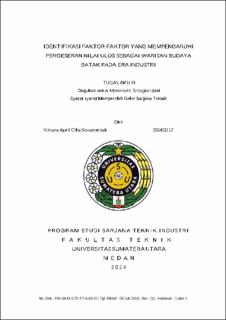| dc.contributor.advisor | Nasution, Harmein | |
| dc.contributor.advisor | Nasution, Fadylla Ramadhani Putri | |
| dc.contributor.author | Simanjuntak, Yohana April Cilia | |
| dc.date.accessioned | 2024-08-28T04:06:52Z | |
| dc.date.available | 2024-08-28T04:06:52Z | |
| dc.date.issued | 2024 | |
| dc.identifier.uri | https://repositori.usu.ac.id/handle/123456789/96251 | |
| dc.description.abstract | The shift in the value of ulos is a change in the values of ulos as a Batak cultural
heritage. Many factors influence changes in the value of ulos in the current
industrial era. Based on observations made on ulos, there are several factors that
influence changes in the value of ulos as Batak cultural heritage, including
technology, economic and cultural values. Current technology has replaced
traditional machines in making ulos which are full of values and philosophy. The
economic value motivation means that ulos is only seen from its economic value
and the existing culture shows the young generation's low interest in traditional
culture due to the influx of foreign cultures which have influenced it. The aim of this
research is to determine the factors that most influence changes in the value of ulos
as Batak cultural heritage in the industrial era so that suggestions can be given to
maintain the value of ulos. This research uses a mixed method type of research with
an exploratory sequential approach. The research method used was a qualitative
method by conducting interviews and distributing open questionnaires to 7 ulos
entrepreneurs, ulos craftsmen and ulos consumers, then a quantitative method by
distributing closed questionnaires to 46 respondents from 6 different types of Batak
tribes and processing the data using SPSS software. The results of qualitative
research show that technology is the most influencing factor and new factors are
discovered, namely educational factors. Then, to test the truth of the qualitative
research results, a quantitative method was used which showed that technological
factors were the factor that most influenced the shift in the value of ulos by 41%,
economic value had an influence of 23.3%, culture had an influence of 12.7% and
education had an influence of 22.9%. % of the shift in ulos value. Therefore, it is
recommended that the role of various parties be played in maintaining the value of
ulos as a Batak cultural heritage | en_US |
| dc.language.iso | id | en_US |
| dc.publisher | Universitas Sumatera Utara | en_US |
| dc.subject | Shift in ulos value | en_US |
| dc.subject | SDGs | en_US |
| dc.title | Identifikasi Faktor-Faktor yang Mempengaruhi Pergeseran Nilai Ulos sebagai Warisan Budaya Batak pada Era Industri | en_US |
| dc.title.alternative | Identification of Factors that Influence Shifting the Value of Ulos as a Batak Cultural Heritage in the Industrial Era | en_US |
| dc.type | Thesis | en_US |
| dc.identifier.nim | NIM200403112 | |
| dc.identifier.nidn | NIDN0025055202 | |
| dc.identifier.nidn | NIDN0025029502 | |
| dc.identifier.kodeprodi | KODEPRODI26201#Teknik Industri | |
| dc.description.pages | 140 Pages | en_US |
| dc.description.type | Skripsi Sarjana | en_US |


